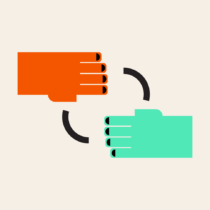What is the Difference: DAM system vs. BAM system?

Find out which system is right for you and your company: a Digital Asset Management (DAM) system, or a Brand Asset Management (BAM) system
It’s no secret: Digital Asset Management (DAM) software is a must-have for organizations of every size, shape and stripe. As brand and marketing content demand and output increase—by as much as 50 percent year-over-year for some teams—the need to efficiently manage, store and retrieve content only becomes more pronounced.
Content isn’t just assets, it’s a critical part of the business process. Content is everything that gives your brand its look and feel, and shapes how consumers and employees see you—from logos and templates, to videos and graphics, to guidelines and training modules. That’s why your content is so valuable. When you think about managing that content and what it means to your broader business goals and a wide variety of audiences and stakeholders, often times a DAM isn’t enough.
Learn More: 7 Ways to Unlock Brand Value through Your Brand center
Sometimes your people aren’t using the brand content on the system consistently. Sometimes they need inspiration on how to apply that content. Sometimes they aren’t taking full advantage of your brand content, but putting data behind it and uncovering engagement opportunities can be difficult. Sometimes you need something more than a typical Digital Asset Management system; this is where a Brand Management System comes in. A BAM can help you advance and sustain your organization’s growth, strategically and holistically.
So what’s the difference between BAM and DAM? And which one’s right for you? Weigh these considerations:
1. What are you trying to solve with your system?
| The case for DAM | The case for BAM |
|---|---|
| Bring order to chaos. Centralize and modernize the way your content is stored and accessed. In the case of an audit, you’re all set. A comprehensive archive and paper trail of every version of every piece you’ve ever produced. | Increase understanding and engagement around the brand. Sustain the brand by getting your people not only the assets they need, but the training and support to know how to use them. |
2. Who’s using your system?
| The case for DAM | The case for BAM |
|---|---|
| A limited number of trained users who collect, manage and access content, and are comfortable self-serving and hand-delivering materials to different teams. Think: a librarian in a library. For this reason, DAM is often priced “per seat.” | A wide range of users from across different functions and business units, with varying needs and levels of expertise. These users are not trained and therefore should have an intuitive user experience. Would benefit from a concierge-style experience, one where a user has all the tools and resources they need to get their job done in one central location. |
3. What kind of content will your system contain?
| The case for DAM | The case for BAM |
|---|---|
| Anything and everything—and every iteration along the way. Every single photo, every cut of every movie, every draft of every design. Likely hundreds of thousands of assets in all. | A more curated selection that includes only the latest version of each asset. The practical stuff that people need on a daily basis and can use feeling secure that they’re putting forth materials that are on-brand and up-to-date. |
Learn more: what is BEAM?
On the surface, both a DAM and a BAM are asset repositories. A digital asset management system is the ultimate way to store, catalog, manage and access a large volume of content that a select group of experts will use. It’s also great for those just-in-case, cover-your-ass scenarios. In contrast, a brand asset management system empowers users to creatively employ your assets in endless applications. A BAM doesn’t just host assets, it provides context and engagement around them so your people have the knowledge, ability and desire to drive your brand forward.
To discover how a BAM helped Deloitte unleash the power of its brand, watch our webinar Sustaining Brand Beyond Day Two: A New Approach to Modern Brand Governance.


